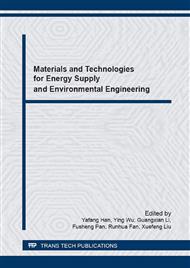p.335
p.344
p.352
p.358
p.366
p.374
p.381
p.391
p.398
Research on Life Cycle Assessment of Plastic Pipeline System
Abstract:
Plastic pipe is a kind of new pipeline material and its output has been increasing in recent years. It is still mainly used for water supply and drainage of buildings and municipal utility industry as well as for safe drinking in rural areas, about half of all plastic pipelines are used for buildings, and the proportion of these pipelines used in other fields is also increasing. Plastic pipeline system's influence on the environment within its life cycle is the focus of researches in recent years. Based on life cycle assessment (LCA), this paper assesses the common water supply and drainage pipelines (PPR, PE and PVC-U) for buildings for resource and energy consumption, non-renewable resource consumption (ADP) of pollution gas emission, greenhouse effect (GWP), acidification effect (AP) and eutrophication (EP) and inhalable inorganics (RI) generated in the process of life cycle from raw material exploitation to produce production and other environmental influence closely related to the national energy conservation and emission reduction policy. The result shows that the influence indexes of non-renewable resource consumption for functional unit of PPR pipe, PE pipe and PVC-U pipe are 2.22×10-5 Kg antimony eq./ kg, 1.51×10-5 Kg antimony eq./ kg, 6.82×10-6 Kg antimony eq./ kg; those of acidification effect are 1.92×10-2kg SO2 eq./ kg, 1.96×10-2g SO2 eq./ kg, 3.90×10-2kg SO2 eq./ kg; those of eutrophication are 2.39×10-3kg PO43-eq./ kg, 2.36×10-3kg PO43-eq./ kg, 3.40×10-3kg PO43-eq./ kg; those of inhalable inorganics are 6.46×10-3 kg PM2.5 eq./ kg, 6.30×10-3 kg PM2.5 eq./ kg, 1.91×10-2 kg PM2.5 eq./ kg; those of greenhouse effect are 3.72kg CO2 eq./ kg, 3.60kg CO2 eq./ kg, 7.93kg CO2 eq./ kg. This result shows that the environmental influence of PPR, PE and PVC-U pipes mainly depends on the raw materials required for producing pipes, so the key of plastic pipeline greening is to reduce the consumption of virgin resin. This investigation creates a database about plastic pipeline's influence on environment within its full life cycle for the purpose of laying a foundation for calculating intrinsic energy in a building, promoting selection of green building material, facilitating the realization of green building objective, and improving the knowledge of developer, constructor and user to potential influence of the pipeline system within its life cycle.
Info:
Periodical:
Pages:
366-373
Citation:
Online since:
March 2016
Authors:
Keywords:
Price:
Сopyright:
© 2016 Trans Tech Publications Ltd. All Rights Reserved
Share:
Citation:


